10 Delicious, Nutritious Fruits You've Likely Never Heard of That Are Growing in Popularity
by www.SixWise.com
Move over apples and bananas, exotic fruits are pushing their
way into supermarket aisles across the country -- and with
good reason.
With surprising flavors, excellent nutrition and a flair
for the dramatic, these fruits can add a little pizzazz to
your daily food choices while giving you nutrients your body
needs and flavors you didn't know you craved!
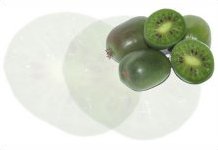 1.
Baby Kiwi
1.
Baby Kiwi
Origins: Kiwis are native to China, but today
New Zealand supplies 99 percent of the world's kiwi supply.
They are also grown in the United States, South Africa and
Europe.
Description: These berries are like grape-sized
kiwis, but without all the fuzz. They can be eaten right
out of your hand, or added to fruit salads and appetizers.
Lore: Kiwis were introduced to New Zealand
in 1906, when they were still called "Chinese gooseberries."
In 1962, the fruit was renamed to honor New Zealand's national
bird, the kiwi.
Key Nutrition Value: Baby kiwis are rich
in vitamin C, fiber, potassium, vitamin E and magnesium.
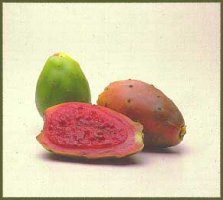 2.
Cactus Pear (Prickly Pear)
2.
Cactus Pear (Prickly Pear)
Origins: Cactus pears are popular in Mexico, the
American Southwest, the Mediterranean, South Africa and
Israel. Native Americans once considered the fruit a delicacy.
Description: With an intense flavor similar to watermelon
and ripe berries, cactus pears can be peeled and eaten raw,
or pureed for sauces, desserts and drinks. Their syrup can
be used for jelly, jam and candy. Cactus pears have a firm,
meaty texture with small, crunchy (edible) seeds.
Lore: Israel natives earned the nickname "sabras"
because they supposedly resemble a cactus pear -- rough
on the outside, but sweet on the inside.
Key Nutrition Value: Along with being high in vitamin
C, magnesium and fiber, a recent study found that cactus
pear extracts contain antioxidants that can improve oxidative
stress. Another study in the Nutrition Journal found
that cactus pear extracts may help to prevent cancer.
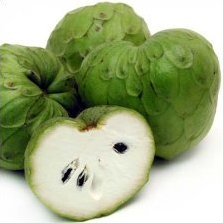 3.
Cherimoya
3.
Cherimoya
Origins: The cherimoya was originally grown by Inca
farmers in Ecuador and Peru. Today it is grown in Chile,
Argentina, Spain, California and New Zealand.
Description: Sometimes called the custard fruit
or custard apple, the cherimoya has a creamy flesh that
tastes like a blend of banana, passion fruit, papaya and
pineapple. It's best eaten straight, by cutting the fruit
into wedges and spooning out the flesh (discard the black,
inedible seeds). They can also be added to fruit salads
and pureed as a mousse or pie filling.
Lore: Mark Twain is said to have called the cherimoya
"deliciousness itself."
Key Nutrition Value: Cherimoya is a good source
of fiber, vitamin B6, potassium and vitamin C.
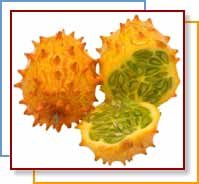 4.
Kiwano Melon (Horned Melon)
4.
Kiwano Melon (Horned Melon)
Origins: The kiwano melon is native to southern
and central Africa. It is also grown in New Zealand and
California.
Description: This melon has a jelly-like flesh with
a sweet/tart flavor that's a mix of bananas, lime and cucumber.
It's eaten by cutting the melon in half and scooping out
the flesh to eat raw or add to desserts or salads. The empty
melon half can be used as a unique serving dish, but shouldn't
be eaten.
Lore: The kiwano melon has been grown for over 3,000
years.
Key Nutrition Value: Kiwano melon contains vitamins
A and C and fiber.
 5.
Kumquat
5.
Kumquat
Origins: Native to China, the kumquat is also grown
in Japan and the United States.
Description: Kumquats look like olive-sized oranges
and have a tart citrus flavor. They can be eaten raw (whole),
but they are commonly cooked and used in jellies, syrups,
stuffing, cakes and muffins.
Lore: "Kumquat" comes from the Cantonese
words kin kü, which means "golden orange."
Key Nutrition Value: Kumquats are an excellent source
of vitamins A and C.
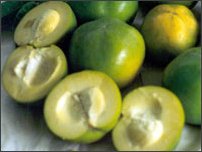 6.
White Sapote
6.
White Sapote
Origins: The sapote is native to Central America,
but is grown in Mexico, Florida and Southern California.
Description: Resembling an apple in size and shape,
sapotes have a custard-like flesh that tastes like a blend
of banana, peach, lemon and coconut. They can be eaten whole,
like a plum, or the flesh can be scooped out with a spoon
(the skin has a more bitter flavor).
Lore: The sapote's skin can range in color from
green to bright yellow. There is also a black sapote, but
it isn't widely available in the United States.
Key Nutrition Value: Sapotes are a good source of
vitamin C, potassium and fiber.
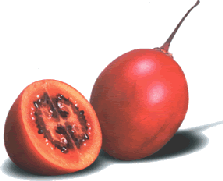 7.
Tamarillo (Tree Tomato)
7.
Tamarillo (Tree Tomato)
Origins: Tamarillos are native to South America,
but are grown in California, New Zealand, Central America,
the Caribbean, Asia and Australlia.
Description: Tamarillos have a tangy, tart flavor.
They must be peeled before being consumed, which can be
done easily by blanching them in boiling water for 2-3 minutes
to loosen the skin (if ripe, the skin should come off by
peeling without blanching). They can be eaten raw, added
to fruit and vegetable salads, or cooked into jams, chutneys
and relishes.
Lore: Tamarillos are related to tomatoes, potatoes,
and eggplants.
Key Nutrition Value: Tamarillos are a good source
of fiber, beta-carotene and vitamin C.
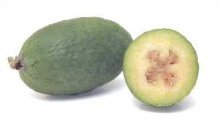 8.
Feijoa
8.
Feijoa
Origins: Native to South America, feijoas are also
grown in New Zealand and California.
Description: Sometimes called the pineapple guava,
feijoas have a gritty pear-like texture with a jelly center
that tastes like a combination of pineapple, guava, lemon
and strawberry. They are most commonly eaten raw, and the
skin can be removed first, as it has a more bitter flavor.
(Simply cut in half and spoon out the flesh.) Feijoas can
also be used in pies, sherbets and smoothies.
Lore: Because of their gritty texture, feijoas are
used in some natural cosmetic products as an exfoliant.
Key Nutrition Value: Feijoas are a good source of
fiber and vitamin C.
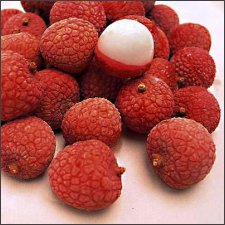 9.
Lychee
9.
Lychee
Origins: Lychees are native to southern China but
are also grown in Asia, India, Japan, Florida, Hawaii and
Australlia.
Description: Lychees have a sweet, grape-like flesh
with a flowery fragrance. They can be eaten raw (peeled),
but their brown seed should be discarded. They can also
be poached and are sold canned and dried in Asian grocery
stores.
Lore: Lychees have been praised in Chinese literature
since 1059 A.D.
Key Nutrition Value: Lychees are an excellent source
of vitamin C -- just 10 lychees supply over 100 percent
of the daily value.
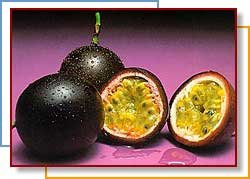 10.
Passion Fruit
10.
Passion Fruit
Origins: Native to Brazil, passion fruits are also
grown in Hawaii, Florida, California and New Zealand.
Description: Passion fruits have a jelly-like flesh
with soft, edible seeds and a sweet/tart flavor. It is typically
eaten raw, by cutting the fruit in half and scooping out
the flesh with a spoon, but it can also be used in sauces,
beverages and fillings.
Lore: Passion fruit is also called a purple "granadilla,"
which means "little
pomegranate." The name "passion fruit"
comes from the bloom of the passion fruit flower, which
symbolizes parts of the Passion of Christ including the
crown of thorns and the nails of the crucifixion.
Key Nutrition Value: Passion fruits are a good source
of fiber, potassium and vitamin C.
Recommended Reading
The
15 Healthiest Berries You Could Possibly Eat ... Including
7 Most Haven't Heard Of
Nutritional
Deficiency: Symptoms & Recommendations for 24 Common Nutritional
Deficiencies
Sources
Nutrition
Journal
Cactus
Pear Fruit Improve Oxidative Stress
CDC:
Exotic Winter Fruit
Melissa's
Produce
Whole
Health MD Food Index